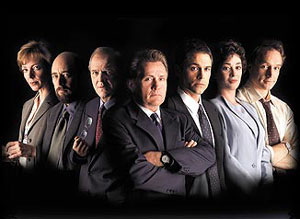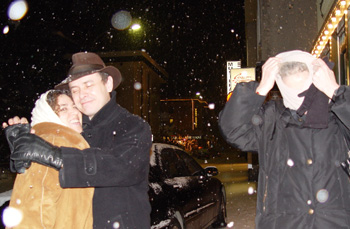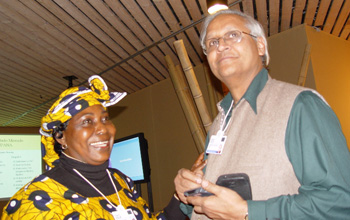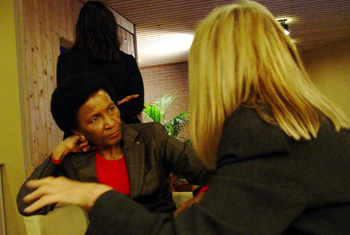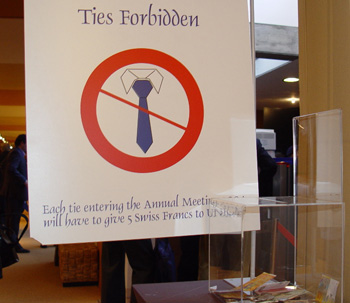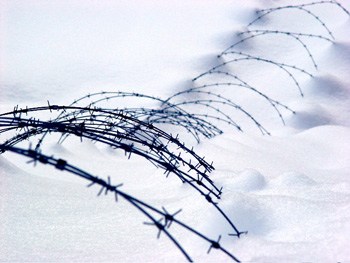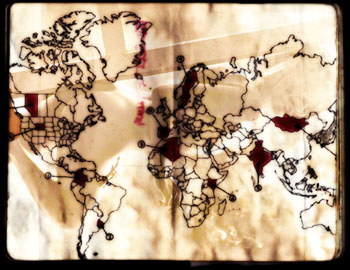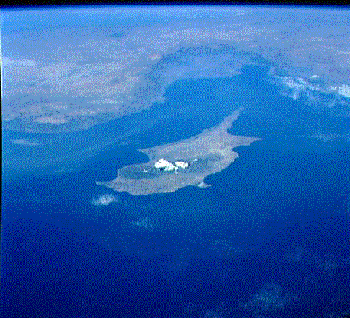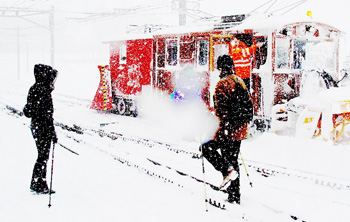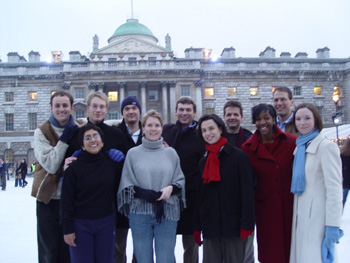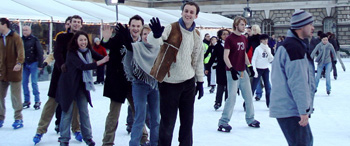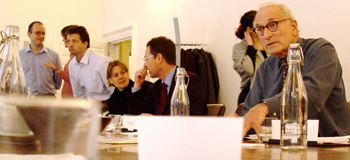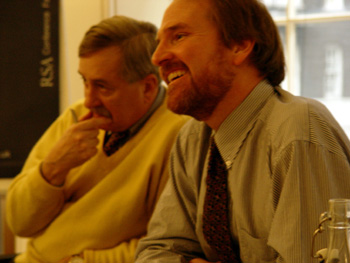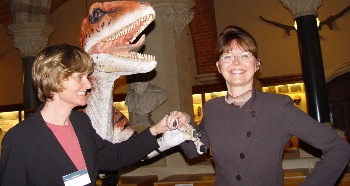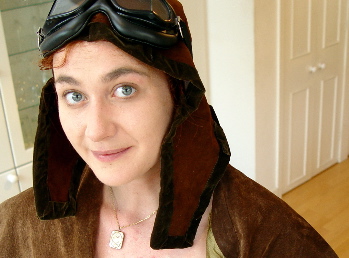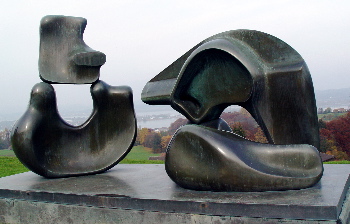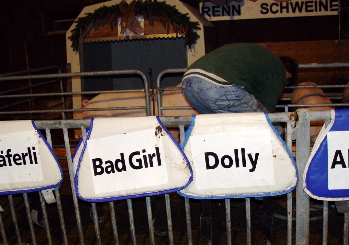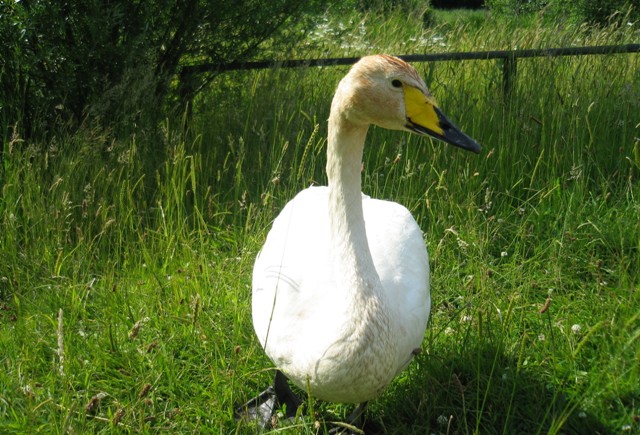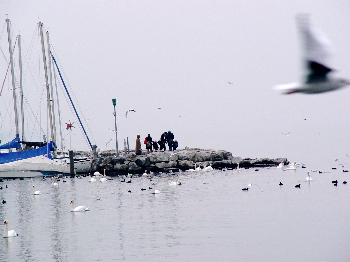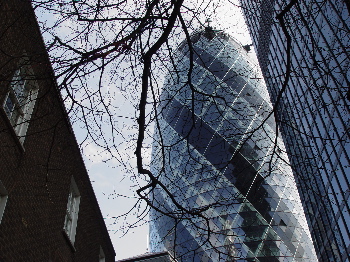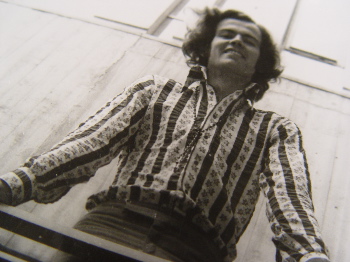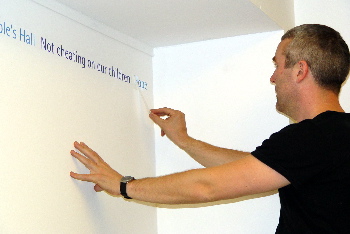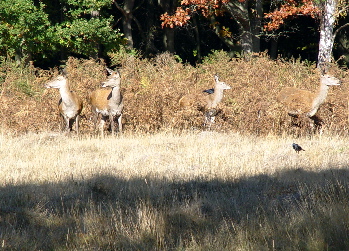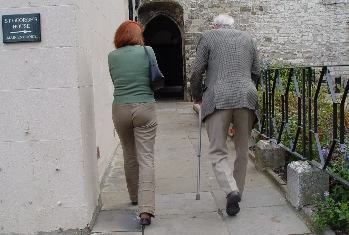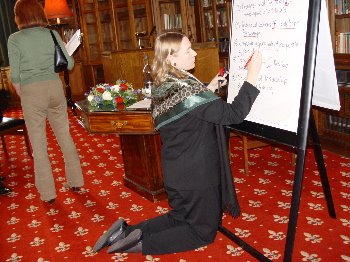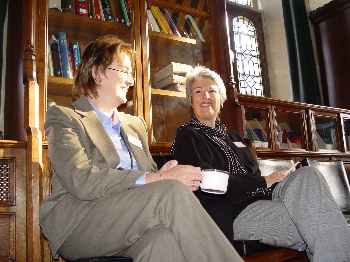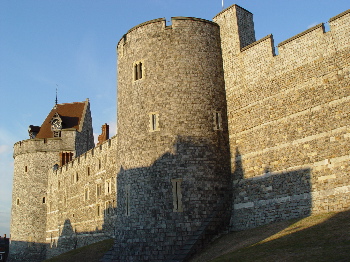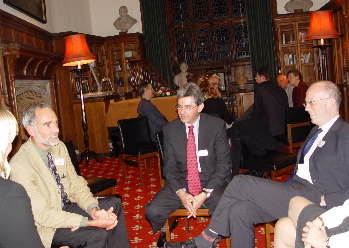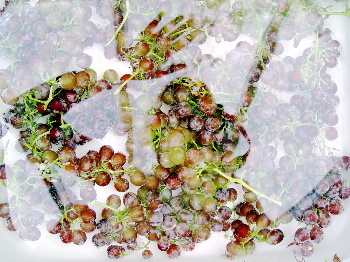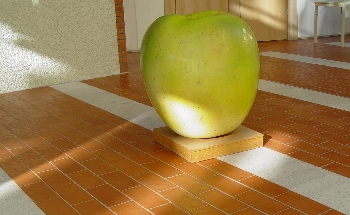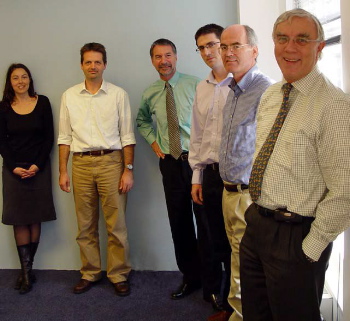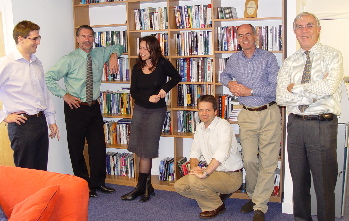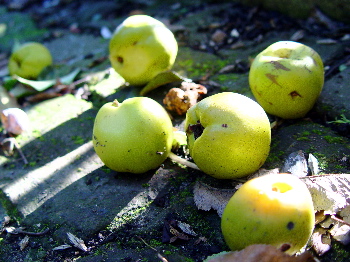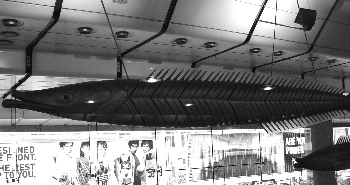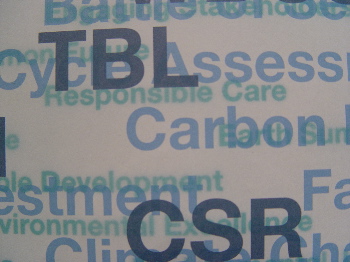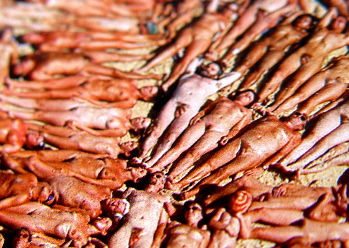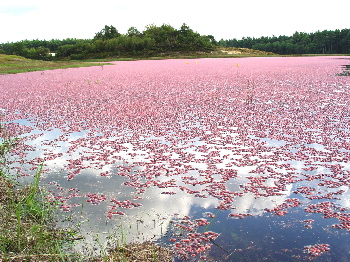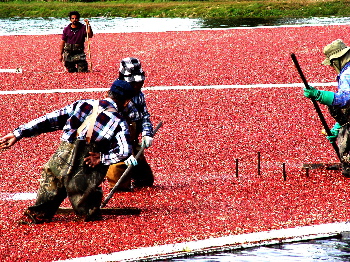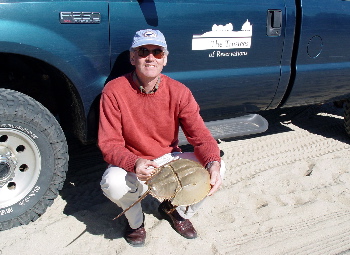Sunday, February 29, 2004
Grand Theft Parsons
Sense of achievement, with major progress on the speeches, after huge brain-ache earlier in the week. Day spent getting Gaia off to her new home in Wiltshire, with two vans (one medium-sized, one tiny) heading west in convoy. Real sense of a watershed, with Hania also starting her new job at a film and TV agency tomorrow. Weirdly, the agency represents Gollum (see 21 February entry).
Yesterday, Hania showed me an advance video of a new film on the life – or rather death – of country-rock star Gram Parsons, Grand Theft Parsons. Though he disliked the term country-rock, that genre was pretty much of his making. The only time I saw The Byrds live, in 1969 in Covent Garden’s Middle Earth club, Gram was playing – this was the time of the vastly underrated Sweetheart of the Rodeo album. Also loved his later work with The Flying Burrito Brothers and with Emmylou Harris. The new film is a delightful tribute not only to Parsons but to the people behind the scenes who have helped keep the whole rockn’roll show on the road. A somewhat elaborated storyline, but a lovely vignette at the end.
Saturday, February 28, 2004
Corporate Predators
The last few days have involved preparing speeches for Atlanta, Baltimore, Berlin and Dubai, on a range of issues, including corporate social responsibility, pollution prevention and sustainable coffee production. Have been struggling to simplify the messages, given the need not just to entertain people but to inspire action.
My other big project at the moment, working closely with Seb Beloe and Jodie Thorpe, is for the UN Global Compact. We are looking at what needs to be done to take business-led voluntary initiatives ‘to scale’. The project also looks at the future responsibilities and roles of governments in this respect. And one of the things I set in train a few days back was a poll of fellow members of the Commission on Globalisation, operated by the State of the World Forum (www.worldforum.org). The replies have started to come in – they’re hugely interesting and provocative. Yesterday, for example, I heard from David Korten (www.davidkorten.org), who has written books like When Corporations Rule the World and The Post-Capitalist Future. He sees corporations, by their very nature and design, as predatory.
And today’s Finanical Times provides eloquent evidence of the continuing fall-out from predatory business like Equitable Life (the pension fund to which Elaine and I once belonged) and Enron. In the latter case, the UK Government – via its Export Credit Guarantees Department, whose Advisory Council I sit on – is now the subject of the largest suit in ECGD’s 30-year-plus history. Standard Chartered, ABN Amro and ANZ are seeking $60 million in relation to losses incurred with the Enron-backed (but ultimately mothballed) Dabhol power project in India. The $2.9 billion project, near Mumbai, was the largest single foreign investment in India. Enron managed to negotiate extremely high power tariffs and was accused of profiteering. The Corner House (www.thecornerhouse.org.uk), one of the most effective NGOs pressuring ECGD and other organs of government on such issues, noted that while non-one was accusing the banks or ECGD of wrong-doing, the project had long been dogged by allegations of corruption and human rights abuses.
Wednesday, February 25, 2004
The Afterlife of Brian
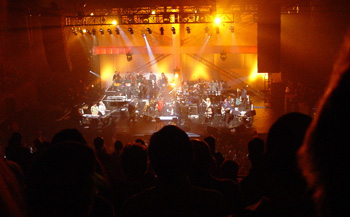
The Afterlife of Brian (©JE)
Just back from the Royal Festival Hall and, thanks to an invitation from Gray (brother), one of the musical highs of my life: Brian Wilson’s Smile concert. It was like witnessing a latter day rising from the almost-dead.
It’s no accident that the musical element of the Influences section of this website contains both the front cover of the Beach Boys’ Surfing USA and, in my ‘Desert Island Discs‘, Good Vibrations. Surfing USA was the first album I ever bought, in 1963 or 64, Good Vibrations remains my favorite pop song, and the Beach Boys feature massively in my music collection.
But this concert was really something else: Brian’s band was staggeringly good, the lost masterwork way beyond my expectations. Interesting, given the sunken wrecks theme of Sunday’s Journal entry, that Brian Wilson once said that reviving Smile would be like raising The Titanic. The Financial Times, no less, had given the opening concert in the series ***** and The Independent went so far as to compare the “perfect mosaic” of Smile to Bach. Gershwin or Cole Porter might be a bit more apt, but to hear songs like Good Vibrations, Heroes and Villains and Surf’s Up in the matrix Wilson had intended was pure magic. Wonderful, too, that the extraordinary lyricist Van Dyke Parks was invited back into the game – and got his own ovation on the first night.
And to have Brian Wilson resurrect first himself and then Smile 37 years after the whole thing disassembled in 1967 was little short of miraculous. But just as striking was the way the band played classics like Surfing USA, California Girls, Dance, Dance, Dance, Help Me Rhonda and Barbara Ann. The music was extraordinary both in terms of how close it was to the originals and of how wierdly 21st century it sounded.
Thank you Gray, thank you Brian.
Sunday, February 22, 2004
HMS Hood
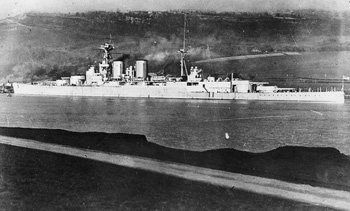
HMS Hood (US Naval Historical Center)
Wonderful white blossom erupting as we walk around the reservoir this afternoon. High wind, with a heron on an island holding itself like a submarine on legs, to minimise wind resistance. Talking to Pat (mother) this evening about recent TV programs on the Dunkirk evacuations; she recalled going down to Chatham shortly before Dunkirk. Remembers the cherry blossom. Whistled aboard HMS Keith, on which her brother Paul’s godfather was serving at the time. Shortly afterwards, the Keith went to Dunkirk, where she was sunk by enemy aircraft: a bomb went straight down her smokestack, apparently. And shortly after that, a friend came by Coalbrookdale and told Pat, Paul and their family what had happened. But it’s alright, he said, Paul’s godfather had been posted before the Keith was sunk. Where? To HMS Hood. She was sunk less than a year later, in May 1941, by the Bismarck (her wreck discovered by Robert Ballard, see ‘Journal’ entry for 30 September 2003). Only three men out of over 1400 survived. Paul’s godfather wasn’t among them. The wreck of the Hood was found 60 years later, in 2001, 2800 metres down in the Denmark Strait (http://hmshood.com).
Saturday, February 21, 2004
Gollum and Dunkirk
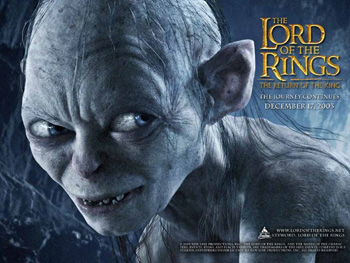
Gollum (© New Line Productions)
Finally saw The Return of the King last night with Elaine and Hania: unbelievable. Gollum must be one of the most perfectly realised characters in film history. And, sadly, there seems to be a Gollum-like character at work nearby. A large black Samsonite trolley suitcase that washed up not far away in Barnes, and was first reported when I was in Barcelona, turned out to contain the remains of a Pakastani woman, Mrs Ahmed, 27, who was a check-in clerk at Heathrow and had vanished on her way to a hairdresser’s on Valentine’s Day. Walked past the spot this evening and the police appeal for witnesses and information: she looked a lovely young woman. Behind, the curving river looked like hammered, blued steel in the dark, a long launch with a brilliant stern light giving the scene a John Buchan touch.
At least she was found. What will palaeontologists millions of years from now, perhaps descended from rats or coatimundi, make of the compacted fossil layers of 20th and 21st century flotsam and jetsam?
On a happier note, Julia (Hailes) stayed with us on Thursday night, en route to speak at an Economist conference, and yesterday afternoon Fran(cesca) van Dijk – who used to work with SustainAbility – dropped in for tea at SustainAbility, with her husband Ken and children Freya and Finn. At a time when I seem to spend much of my life hauling trolley suitcases through airports, it’s tremendous to renew long-standing friendships. And that’s what I feel with The Lord of the Rings. Reading the 3-volume series in the late 1960s was one of the most powerful experiences of the era – and Peter Jackson has more than done Tolkien justice.
This evening, we watch the Battle of France program, featuring No. 1 squadron and the excavation of Billy Drake’s Hurricane (see 6 February entry). Reminiscent of the excavation of Tim’s own Hurricane (see Influences/Family/The True Battle of Britain). Very moving, as was the following BBC2 program on Dunkirk, featuring extraordinary archive footage and interviews of veterans. Julia’s father Jack was captured during this period and spent the war as a prisoner of war.
Wednesday, February 18, 2004
Barcelona
Just in from Barcelona, having seen a quite spectacular aerial view of what can only have been Beachy Head, its chalk cliffs brilliantly lit by the early morning sun. Last night I gave a lecture to several hundred people at a leading business school, ESADE (Escuela Superior de Administracion y Direccion de Empresas). When I arrived, I unexpectedly found myself pitched into a TV interview and then back-to-back interviews with two major newspapers. One issue that came up repeatedly, both in the interviews and in discussion with ESADE Faculty members over lunch and dinner, was what they called “the sustainability of employment”. I was asked by one professor whether we had worked in this area and initially answered no, then recalled the fairly extensive piece of work we have just done with BT on the “geography of jobs“. That will be published imminently.
The immediacy of the issue in Spain was brought home forcefully this morning when I picked up a copy of The International Herald Tribune. ‘Spanish labor clashes at dockyards leave 60 hurt’ was the caption of a photograph showing damage from a violent confrontation between dock workers and police in Seville, which left 38 workers and 12 policemen hurt. Another 10 officers were injured in a related battle in Cadiz. From our US office, Philippa (Moore) sent me a listing of US companies today that are being pilloried for exporting jobs by a CNN program hosted by Lou Dobbs (http://www.cnn.com/CNN/Programs/lou.dobbs.tonight/).
The US presidential election is certainly turning the heat up under this one – and the rest of the world is going to get an idea of just how committed the US is to globalisation on anyone’s terms but their own. A semi-sore point with me, having been stopped a couple of times when entering the States, particularly in Detroit, and asked by aggressive immigration officals why Americans can’t do the work we’re doing?
Sunday, February 15, 2004
Up A Tree
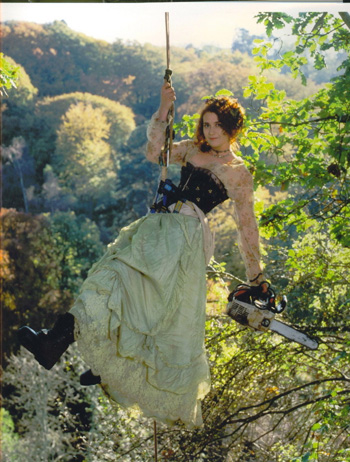
Gaia, with para boots, chainsaw and family heirloom
Last night, Elaine, Hania and I watched the New Zealand film Whale Rider, the story of a Maori girl who has to fight her grandfather to become chief of her tribe. The dramatic tension flows from the fact that women are not allowed to be chiefs, or to take part in the training of chiefs. The high point is when she rides a right whale after a mass stranding of a pod of right whales, which she appears to have caused.
The story put me in mind of a picture of Gaia (see above) which I couldn’t use in the main body of this website because its dimensions didn’t fit Rupert’s design. After her time with the anti-road-campaigners, she got her teeth into the arboreal world and went off to Merrist Wood to train to be a tree surgeon. The only female student on the course. She succeeded and then went back to Edinburgh to set up The Lumberjills, to do tree work in the city and its surroundings. This picture was taken for a profile of her in The Glasgow Herald. Wearing an old family heirloom: I think because the journalist wanted to cover both her forestry antics and her exploits in the field of fashion. It all comes to mind, I suspect, because she is folding her tent in Edinburgh and moving south in a week or two.
As to Gaia and Hania’s surviving grandparents, I spoke to Pat and Tim today. Pat talked of the attrition rate in the group of pilots in the photos I had sent them (see 6 February entry). Only two of the pilots in the group shot survived, Tim and Pat Hancock (in Mae West jacket) – who died last year. One of the group with the Hurricane, F/Lt Demozay, wearing a dark French uniform, was a French pilot who had been flown out of France sitting in the lap of a Spitfire pilot. He, too, was killed.
Tim said he had just been to have an X-ray for his knees. Apart from the arthritis, the doctors were surprised to find his knees splattered with dark spots. It’s shrapnel from when he was shot down in the Battle of Britain. Asked whether he wasn’t worried about contamination, he said it had all been pretty well cauterised when the Hurricane’s fuel tank blew up.
Friday, February 13, 2004
Great Whites Et Al
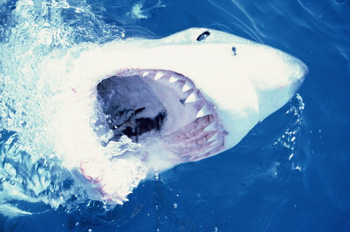
Great white shark (www.animalyawns.com/sharksleft.htm)
Started yesterday with my mouth open wide, in the arms of the dentist. Then, last night, I gave the second in a new series of Linacre Lectures at Oxford University on the subject of NGO accountability, following on from the first lecture last week by Tony Juniper of Friends of the Earth. Nice welcome from Paul Hannam and Dr Paul Jepson of Oxford’s Environmental Change Institute (ECI), then on to tea with Professor Paul Slack, Linacre College’s Principal, and a number of his colleagues, including Professor Diana Liverman, who now runs ECI (www.eci.ox.ac.uk).
To get things off to a lively start, my second slide was of a great white shark, as a trailer for our NGO typology of Sharks, Killer Whales (Orca), Sealions and Dolphins. This resulted from a project we did for BP’s board in 1996, but also featured in our recent report The 21st Century NGO. The original idea was suggested by the thinking of Max Nicholson, who argued that NGOs could be broken down into polarisers and integrators on one axis, and discriminators and non-discriminators on the other. We took that idea and dropped marine creatures into each of the resulting four cells, as follows:
Shark (non-discriminating polarizers): Acts on instinct, tactical at best, attacks any target in distress, often attacks in packs, and happiest in feeding frenzies; not particularly receptive to new information once there is blood in the water.
Orca (discriminating polarizers): Highly intelligent, strategic, hunts over long distances, operates in ‘resident’ and ‘transient’ modes (‘residents’ hunt salmon, therefore keep their dorsal fins above water and make a good deal of noise, since their prey – salmon – can’t hear and doesn’t spend much time looking about above water; while ‘transients’ hunt marine mammals which can both see and hear, so run deep and silent), and attacks not only seals and sealions but also, sometimes, dolphins.
Sealion (non-discriminating integrators): Keen to please, attractive to mass audiences, ‘performs tricks for whoever has the bucket of fish’, often professional and well trained, prefers inshore waters, and gets anxious if separated from the group.
Dolphin (discriminating integrators): Great capacity to learn, adapts strategies and behaviours to context, creative, playful, can fend off sharks.
Happily, the debate with the capacity audience took off, with a forest of hands when the open forum was announced. And it’s interesting how well the 1996 work has stood the test of time. When we did the original research for BP, we found a great many NGOs heading, or wanting to head, into the ‘Dolphin’ space. Hence the title of the resulting report: Strange Attractor.
Last night I was asked, once again, where I would place SustainAbility in the matrix? At the time of the original research, a fair number of people saw us operating in – even defining – the Dolphin space. But as a number of us walked back from the lecture last night, I wondered – tongue very firmly in cheek – whether we aren’t sometimes a bit like a Portuguese Man’o’War, drifting in from outside the frame, stinging everything in sight and then drifting off into the blue? In reality, though, we have always been very much pro-NGO, are often taken for an NGO ourselves (we have been described variously as a ‘for-profit NGO’ and a ‘campaigning company’), and are determined to help NGOs wake up and adapt in good time to the emerging accountability challenge.
Wednesday, February 11, 2004
Cannes
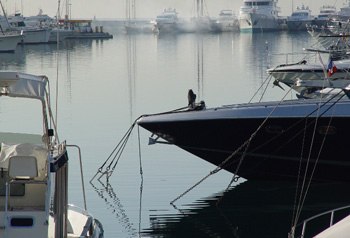
‘Eagle owl’ in Second Port, Cannes (©JE)
Having signed a confidentiality agreement, probably all I can say is that I was in Cannes on Monday and Tuesday, speaking at a conference organised in the Inter-Continental Carlton Hotel by a major pharmaceutical company. One key issue we discussed was the sustainability of their business model.
In the morning, I walked east along the Boulevard de la Croisette, hard by the Mediterranean. The sky was brilliant blue, the pavement recently washed, roller-bladers scooting by. The thin strip of sand between the boulevard and the Baie de Cannes was densely pock-marked by footprints and caterpillar tracks. Everywhere the sound of motors: cranes, bulldozers, jackhammers, scooters, cars, buses, trucks, motor-boats. As I walked around the Second Port and Port Canto, marvelling at the size of the yachts, and at the number of ‘For Sale’ notices they sported, my eye was caught by one boat whose brilliant paintwork was protected by a large model eagle owl. Odd, end-of-the-world feeling.
Saturday, February 07, 2004
Angels
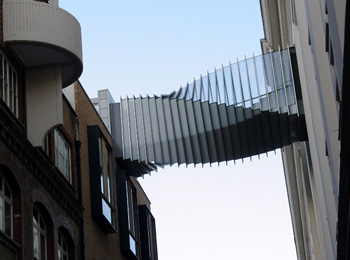
Covent Garden 07-02-04 (©JE)
Bridges and angels’ wings seemed to be everywhere today. The bridges corkscrewed aerially between buildings in Covent Garden, in the show Anything Goes (with the SS American as a floating bridge between the New World and Old), to which Hania took us as a birthday present for Elaine, and then again in Angels in America (with angels bridging this world and the next by crashing through ceilings), which ran on Channel 4 from 21.00 to after midnight. Extraordinary television.
I remember being blown away by Cole Porter’s Anything Goes (dating from 1934) when it was covered by Harper’s Bizarre in 1967 (still have the LP, one of the first I bought on going to university), but this afternoon I was particularly taken by ‘Blow, Gabriel, Blow’, the mock-spiritual belted out by Reno and the Angels.
So maybe, on reflection, it was angels that were ubiquitous? This evening, Tim (father) e-mailed photos of a new painting Caroline (sister) has just done of Gaia (daughter) dressed as Amelia Earhart (who disappeared in the Pacific in 1937), complete with aviator’s goggles (see sample, 30 November 2003). And that reminded me of when Gaia used to go to school (St Paul’s) wearing a huge pair of home-made angel’s wings, which she would sit and quietly flap during morning assembly.
My memory is that the High Mistress decided that the wings should be banned. Unfortunately for the authorities, there was nothing in the school’s rules allowing wings to be banned – so they were redefined as a hat and banned as such. That sparked something of a rebellion, with students and staff divided on whether this wasn’t a bit dictatorial? Gaia was summoned and asked whether the wings were being worn with seditious intent? She replied that she wore them because they made her – and others – happy. So the ban was removed. Contrary creature that she is, Gaia promptly shed the wings.
Friday, February 06, 2004
Sgts Berry and Albonico
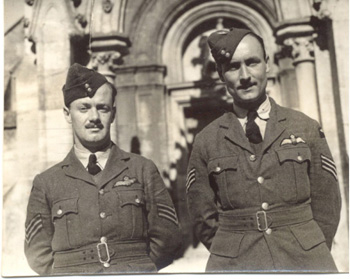
Sgts Berry and Albonico
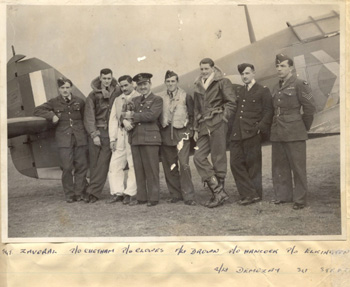
Pilots of No 1 squadron, with Tim (my father) third from right
Fascinating unsolicited e-mail from John Hayes-Fisher today, linked to the Battle of Britain story told elsewhere on this site (see under Influences/Family, then click on Battle of Britain).
Dear John
I have come across your name on many occasions, probably initially through my degree (Environmental Studies) and in the New Scientist and almost certainly when I made a programme over 10 years ago on sustainability for BBC2’s Nature Series, when Michael Buerk was the presenter.
However the reason why I’m writing is completely unrelated. I am making a programme about the RAF’s No 1 Squadron in the Battle of France and I was searching the web for references to armour plating being fitted to Hurricanes. I think it was with this search that I came across the article you had written in the Guardian about your father’s time with the Squadron and noticed reference to Sgt Berry who was one of the pilots with No 1 Squadron in France – and as you say was later killed in the Battle of Britain.
I believe that Berry was instrumental in saving your father’s life and I thought you might be interested in seeing a photo of Berry taken outside the town hall at Neuville, where the Squadron were billeted for the Autumn of ’39 and first part of 1940. I am also sending a copy of another photo I have found in the No 1 Squadron scrapbook which we are borrowing for the programme. Needless to say, you will probably recognise the man third from the right.
Our programme is probably going out on BBC2 at 8pm on Saturday 21st February and is called Billy and the Fighter Boys. As I say, it’s about No 1 Squadron’s time in the Battle of France and in it we follow aviation archaeologists as they discover the remains of Billy Drake’s Hurricane, which he bailed out of in May 1940, and excavate it while he is present. Maybe your father might be interested in watching? Being in Billy’s company has left with a deep sense of humility and admiration for the pilots of 1940, one which I hope comes out in the programme.
Regards
John
Thursday, February 05, 2004
Nike
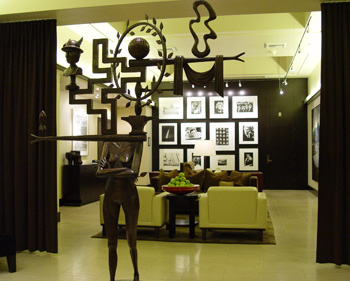
Statue in Hotel Lucia symbolises multidimensional stakeholder process – at least in my mind.
Just in from supper with Elaine and Mark Lee, who is joining SustainAbility from BSR. Arrived back in London earlier today from Portland, via San Francisco (which, coincidentally, is where Mark is based). Had gone to take part in what was billed as Nike’s first major multistakeholder event, on Tuesday and Wednesday. Nike, to be fair, have already done a fair amount of stakeholder engagement – indeed, I took part in one interesting session they hosted in Portland a few years back. This time, though. the event was on a much larger scale and was held in the Tiger Woods building on the Nike campus. Stakeholders were broadly very positive – and keen that other companies should do similar sessions.
The three key themes focused on what Nike should do in relation to: the imminent ending of the multi-fibre arrangement (MFA); gender issues in the supply chain; and China. A fascinating learning experience on all fronts – and remarkably well run by Nike. Facilitated by David Sibbett of The Grove Consultants International (www.grove.com), who charted the evolving debate on vast sheets of paper. So quick and accurate was he that one person said it was almost as if he was “chaneling”.
The MFA issues were almost all news to me. I had read about the planned ending of the MFA quota system for textiles and clothing around the time of the World Trade Organisation (WTO) ministerial meeting in Doha, when most developing countries were gung-ho about ending what they then saw as an unfair trade system. At the time, Sri Lanka claimed that the end of the MFA would boost its share of trade in these areas, while the Bangladeshis actively lobbied for a quicker phase-out of the MFA. Today, by contrast, as the International Textile Garment & Leather Workers’ Federation (ITGLWF) puts it, “panic is the order of the day in most textiles and clothing exporting nations as governments contemplate industrial meltdown.”
A key reason for the shift in opinion is that other developing countries have only recently woken up to the degree to which China is likely to win in the new game. And the likely impact on their own economies – reflecting huge dependency on exports of textiles and clothing – is illustrated by the fact that for many least developed and small developing countries the sector now accounts for more than 90% of industrial exports and more than 50% of total employment. On current evidence, the impact on employment in countries like Bangladesh and Sri Lanka could be profound. The question for Nike and the other stakeholders present: What can be done to at least moderate the negative impacts?
On the flights out, I read Cold Comfort Farm, by Stella Gibbons, which Geoffrey Chandler gave me recently. Published in 1932, the book is delightful, funny and very much a work of its period: it talks of a “Jew-shop” and looks forward into a near-future in which there have been modest little wars (there is mention, I recall, of an Anglo-Nicaraguan war of ’46). Weird that people couldn’t sense the disturbance in the force-field caused by the impending WWII. What are we missing in the same way today? On the flights back, I read most of Steve Kemper’s book Code Name Ginger: The Story Behind Dean Kamen’s Quest to Invent a New World. Kamen (www.dekaresearch.com) was the man behind the Segway Human Transporter, launched a while back after a period of intense secrecy and hype. His interest in technologies like the Stirling engine and water treatment technologies for the developing world potentially make him someone to try to talk to for the social entrepreneurs book.
Sunday, February 01, 2004
It’s the System Stupid
A WEF piece I wrote today. Edited version posted on http://www.opendemocracy.net on 5 February.
‘IT’S THE SYSTEM, STUPID!’
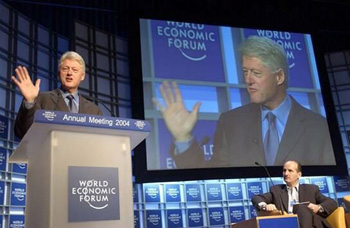
Former Presidents Bill Clinton and Jose Maria Figueres (©WEF)
Even when jet-lagged, Bill Clinton knows how to hold Davos Man and Woman in the palm of his hand. Count me more or less in their number. Kicking off this years World Economic Forum (www.weforum.org) on 21 January, he used language which was to resonate through the rest of that high-octane, high testosterone week. Nothing new there: Google the phrase Its the Economy, Stupid! – the 1992 Clinton-Gore campaign slogan – and youll find its echoes everywhere. But now, it seems, Clintons implicit message when on the broad range of economic, social and environmental challenges we face is, Its the System, Stupid!
Instead of making flying visits to people like the Grameen Banks Muhammad Yunus, he suggested, we should bring Yunus and folk like the property-rights-for-the-poor campaigner Hernando de Soto in from the cold. Mainstream them. No doubt some corporate bottoms shifted uneasily in their seats at this call for some sort of Third Way revolution, but what exactly was Clinton prescribing, exactly? Sadly, at least in my memory, he was long on concept and short on detail.
He was, he said, all for systematic change, but the scale of the challenges we now face requires systemic change. Well, fine, and no doubt he would have won nods from many of those across the road at the Public Eye on Davos (www.evb.ch) and, indeed, at the anti-WEF World Social Forum, held this year in Mumbai, India (www.wsfindia.org). But most of these people, I suspect, would have soon parted company with the Davos crowd even with Clinton – in terms of how much, how far, how fast and at whose expense.
Thinking back, though, it strikes me that it would be easy to over-dramatise the chasm between Davos and Mumbai. The divides are there, of course, but, willingly or not, both sides are in the process of adjusting their mindsets. In fact, this was the third time I had attended the World Economic Forums annual summit and I was forcefully struck by just how far both the nature and content of the debate have shifted over the past three years.
At WEF, many once forceful globalizers are now off balance, some even taking part in sessions on corporate social responsibility and sustainable development. Its not yet a question of Globalizers Anonymous, but the agenda is a lot more nuanced than it was just a few years back. And, for the most part still in a parallel universe, a growing number of former anti-globalizers are trying on labels like alter-mondialiste and talking in terms of responsible globalisation.
Several swallows never did make a summer, but the basis for some form of convergence is clearly there. That really wasnt the case a few years back. The first time I got the call, in 2002, the WEF event was held in New York, in the wake of the 9/11 attacks. The following year, 2003, most of the caravan returned happily to snowy Davos, in Switzerland. This time, though, there were bitter recriminations between America and its allies – who were actively planning for war and those who opposed invasion, with or without UN sanction. One of the sessions I remember best was the one where General Wesley Clark pointed energetically to places on the map of Iraq where the coalition forces expected to be attacked with anthrax and other weapons of mass destruction.
What a difference twelve months can make. This year, by contrast, US Vice-President Dick Cheney was in conciliatory mood. And my overall impression, while British Foreign Secretary Jack Straw drew no cheers for his lacklustre defence of the Iraqi venture, was that most participants were much more interested in what would happen to the US recovery and to the dollar. Most seemed to have little appetite for major changes in the economic architecture.
And something else had changed too, it seemed to me. Looking back, 2002 saw the WEF summit in New York invaded by a fairly considerable number of NGOs and fellow travellers, myself included. The trend evolved further in 2003. On both occasions, demonstrations in the streets outside helped keep the political pot bubbling. You could almost feel the steam percolating up through the floorboards into some of the sessions. This year, by contrast, the security forces choked off most of the protests in and around Davos, and whether it was a related trend or not the NGO voices seemed muted.
Behind the scenes, true, there were clashes between WEF officials and some NGOs on the best ways forward. Afterwards, the head of one highly reputable NGO told me that he they – would not be coming back. I could understand the frustration. A couple of the parallel sessions I attended were surprisingly glib and ill-informed, although in my experience they were the exception. While you hear some of their research partners seethe that the relationship with WEF is pretty one sided, with the Forum claiming most of the credits, it has positioned itself as the most coherent global platform for integrated debate in this area.
When I challenged WEF co-CEO Jose Maria Figueres, a former president of Costa Rica, on the issue of whether the Forum would ever take a stand position on a major policy issue, he stressed that it is essentially neutral in what it does. But, however you judge that claim, it really is leaning into the debate a bit more these days.
This year, for example, the WEF Global Governance Initiative launched its first annual report . And it is surprisingly critical of current efforts to tackle the priority issues identified at the 2000 UN Millennium Summit, in the form of the Millennium Development Goals. Scoring each of seven areas of activity out of a maximum of 10 for 2003, WEF set the numbers such that a 0 means retrogression, whereas a 10 means that the world that is, national governments, businesses, civil society and international organizations taken together – essentially did everything needed to be on track to reach the goals.
The report came up with the following results: peace and security (3), poverty (4), hunger (3), education (3), health (4), environment (3) and human rights (3). Reading the numbers, it struck me that the world really deserves a school report I got some time late in the 1950s: Sets himself low standards and consistently fails to achieve them.
Whatever you think of WEF, this is an important contribution. Nor is this the only initiative WEF is helping drive forward in this area. Indeed, one of the reasons the NGOs probably seemed a bit muted to me this year was that the voices of the social entrepreneurs in Davos had been wound up several notches. Convened by the Schwab Foundation (www.schwabfound.org), also founded by WEF founder Klaus Schwab and his wife Hilde, the entrepreneurs came together for the first time at the WEF summit in New York. After a slightly wobbly start, more of them hit the ground running in Davos in 2003 and most really got into their stride this year.
Most social entrepreneurs today are unknown to the general public. Some, like Muhammad Yunus or Bunker Roy of the Barefoot College, may be well known to Bill Clinton and be covered fairly regularly in the international media, but for most of us most of what they do tends to disappear into the background noise. Nor are they guaranteed to succeed. Many of them will fail, some more than once. Such is the life of entrepreneurs, perhaps even more so of social entrepreneurs. But these people have the potential to transform the way in which hundreds of millions of people live, learn and work.
A huge and growing variety of social entrepreneurs are tackling such issues as environmental protection, family planning, the empowerment of women, fair trade, food security, the homeless, HIV/AIDS orphans and youth development. Where markets fail, as they do in relation to many of these issues, social entrepreneurs are working on leapfrog thinking, technology and business models to do the previously undoable. They are not primarily motivated by profit although many are more than happy to make a profit.
In short, the phrase The impossible takes a little longer could have been coined for them. It has been my great good fortune to be in the passenger seat as they began their WEF breakthrough. In 2002, I sat in on the first WEF social entrepreneur session in New York. In 2003, I facilitated the first Davos social entrepreneurs session. And this year, with Pamela Hartigan, who runs the Schwab Foundation, I had the extraordinary privilege of interviewing 15 or so social entrepreneurs for a book we are planning. Thats around a quarter of the Schwab Foundations current network – and I emerged supercharged.
No wonder Clinton name-checks these people in his speeches. Both he and UN Secretary-General Kofi Annan have every excuse for pleading exhaustion in the wake of their continuous efforts to get these issues onto the political agenda. But an hour with any of these entrepreneurs is like the shot of monkey gland extract that some rich people apparently used to come to Switzerland for. (And, who knows, perhaps some of the Davos crowd still do?)
Whatever, the real question right now is how we can initiate the necessary top-down changes to the market system to help social entrepreneurs bring their bottom-up activities to scale. Maybe it will help if we adopt the Its the System, Stupid! mantra, even sticking it on our fridge doors. But we can all be sure of one thing: only if we are prepared to throw our collective weight behind these extraordinary pioneers can we hope to see evidence of real progress in future Global Governance Initiative scorecards.

